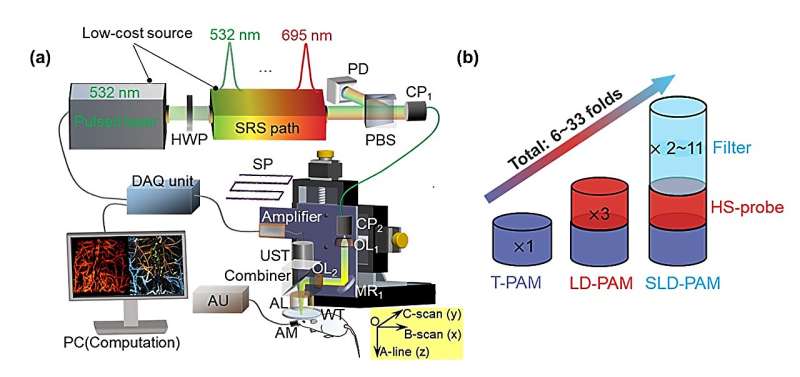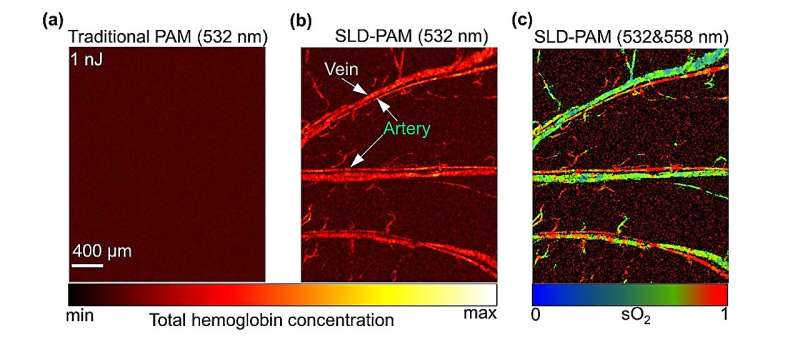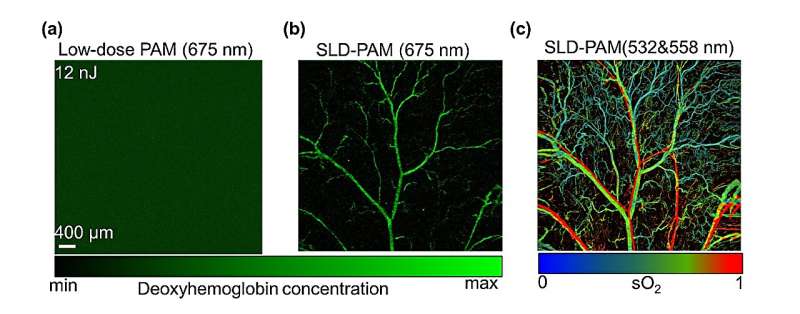This article has been reviewed according to Science X's editorial process and policies. Editors have highlighted the following attributes while ensuring the content's credibility:
fact-checked
peer-reviewed publication
trusted source
proofread
Researchers develop ultra-sensitive photoacoustic microscopy for wide biomedical application potential

Optical-resolution photoacoustic microscopy is an up-and-coming biomedical imaging technique for studying a broad range of diseases, such as cancer, diabetes and stroke. But its insufficient sensitivity has been a longstanding obstacle for its wider application.
Recently, a research team from City University of Hong Kong (CityU) developed a multi-spectral, super-low-dose photoacoustic microscopy system with a significant improvement in the system sensitivity limit, enabling new biomedical applications and clinical translation in the future. The findings were published in the journal Advanced Science under the title "Super-Low-Dose Functional and Molecular Photoacoustic Microscopy."
Photoacoustic microscopy is a biomedical imaging technique that combines ultrasound detection and laser-induced photoacoustic signals to create detailed images of biological tissue. When biological tissue is irradiated with a pulsed laser, it generates ultrasonic waves, which are then detected and converted into electric signals for imaging. This technique can achieve up to capillary-level or sub-cellular resolution at greater depths than traditional optical microscopy methods. However, insufficient sensitivity has hindered the technology's wider application.
"High sensitivity is important for high-quality imaging. And it helps detect chromophores (molecules that confer color on materials by absorbing particular wavelengths of visible light) that do not strongly absorb light. It also helps lessen photobleaching and phototoxicity, reduce perturbation to the biological tissues of delicate organs, and broaden the choices of low-cost, low-power lasers in a wide spectrum," explained Professor Wang Lidai, Associate Professor in the Department of Biomedical Engineering at CityU.
For instance, in an ophthalmic examination, a low-power laser is preferred for more safety and comfort. Long-term monitoring of pharmacokinetics or blood flow requires low-dose imaging to alleviate perturbation to tissue functions, he added.

To overcome the sensitivity challenge, Professor Wang and his research team recently developed a multi-spectral, super-low-dose photoacoustic microscopy (SLD-PAM) system that breaks through the sensitivity limit of traditional photoacoustic microscopy, significantly improving sensitivity by about 33 times.
They achieved the breakthrough by combining improvement in the photoacoustic sensor design and innovation of a 4D spectral-spatial filter algorithm for computation. They improved the sensor design by using a lab-customized high-numerical-aperture acoustic lens, optimizing the optical and acoustic beam combiner, and improving the optical and acoustic alignment. The SLD-PAM also utilizes a low-cost multi-wavelength pulsed laser, providing 11 wavelengths, ranging from green to red light. The laser operates at a repetition frequency up to megahertz, and the spectral switching time is in sub-microseconds.
To demonstrate the significance and novelty of SLD-PAM, the team tested it thoroughly via in vivo animal imaging at super-low pulse energy with green-light and red-light sources, resulting in remarkable findings.
First, SLD-PAM enabled high-quality in vivo anatomical and functional imaging. The super-low laser power and high sensitivity significantly reduced perturbations in eye and brain imaging, paving an avenue for clinical translation. Second, without compromising image quality, SLD-PAM reduced photobleaching by about 85%, using lower laser power, and enabled the use of a much broader range of molecular and nanoprobes. In addition, the system cost is significantly lower, making it more affordable for research laboratories and clinics.

"SLD-PAM enables non-invasive imaging of biological tissue with minimal damage to the subjects, offering a powerful and promising tool for anatomical, functional and molecular imaging," said Professor Wang. "We believe that SLD-PAM can help advance the applications of photoacoustic imaging, enable numerous new biomedical applications, and pave a new avenue for clinical translation."
Next, Professor Wang and his research team will test a broader range of small molecules and genetically encoded biomarkers in biological imaging using the SLD-PAM system. They also plan to adopt more types of low-power light sources in a wider spectra to develop wearable or portable microscopy.
More information: Yachao Zhang et al, Super‐Low‐Dose Functional and Molecular Photoacoustic Microscopy, Advanced Science (2023). DOI: 10.1002/advs.202302486



















